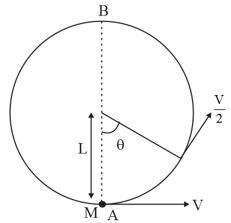- Tardigrade
- Question
- Physics
- Two metal strips are riveted together at their ends by four rivets, each of diameter 6 textmm . Assuming that each of the rivets carries one-quarter of the load, the maximum tension that can be produced in the riveted strip is [Breaking shear stress of the rivet = 6.9× 107 Pa ]
Q. Two metal strips are riveted together at their ends by four rivets, each of diameter $6 \, \text{mm}$ . Assuming that each of the rivets carries one-quarter of the load, the maximum tension that can be produced in the riveted strip is [Breaking shear stress of the rivet = $6.9\times 10^{7} \, Pa$ ]
Solution:
Diameter of each rivet $\left(\right. \text{D} \left.\right) = 6 \, \, \text{mm}$
$\therefore \text{Radius (r)} = \frac{\text{D}}{2} = \text{3 mm} = 3 \times \left(\text{10}\right)^{- 3} \text{m}$
Maximum shearing stress on each rivet = 6.9 × 107 Pa
Let w be the maximum load that can be subjected to the riveted strip.
As each rivet carry one-quarter of the load, therefore
$\text{Load on each rivet} = \frac{\text{w}}{4}$
$\text{Maximum shearing stress} = \frac{\text{Maximum shearing force}}{\text{Area}} \, \, \, $
$\therefore \text{6.9} \times \text{10}^{7} = \frac{\text{w / 4}}{\text{\pi } \text{r}^{2}}$
or $\text{w} = 6.9 \times 10^{7} \, 4 \text{\pi r}^{2}$
or $\text{w} = 6.9 \times \left(10\right)^{7} \times 4 \times 3.1 \, 4 \times \left(\right. 3 \times \left(10\right)^{- 3} \left.\right)^{2}$
$= 6.9 \times 4 \times 3.14 \times 9 \times 10$
$= 7.8 \times 10^{3} \, \text{N}$
Questions from NTA Abhyas 2020
2. The velocity displacement graph of a particle moving along a straight line is -

The most suitable acceleration-displacement graph will be
Motion in a Straight Line
3. A drum of radius $R$ and mass $M$ rolls down without slipping along an inclined plane of angle $\theta $ . The frictional force
System of Particles and Rotational Motion
Physics Most Viewed Questions
1. If $E$ and $G$ respectively denote energy and gravitational constant, then $\frac{ E }{ G }$ has the dimensions of:
NEET 2021
Physical World, Units and Measurements
2. The de Broglie wavelength of an electron moving with kinetic energy of $144 \,eV$ is nearly
NEET 2020
Dual Nature of Radiation and Matter
3. A car starts from rest and accelerates at $5\, m / s ^{2}$ At $t=4\, s$, a ball is dropped out of a window by a person sitting in the car. What is the velocity and acceleration of the ball at $t =6\, s$ ? (Take $\left. g =10\, m / s ^{2}\right)$
NEET 2021
Motion in a Straight Line
Latest Updates
- JEE Main 2023 February 25th Shift 1 Morning
- JEE Main 2023 February 25th Shift 2 Evening
- JEE Main 2023 January 31st Shift 1 Morning
- JEE Main 2023 January 31st Shift 2 Evening
- JEE Main 2023 January 30th Shift 1 Morning
- JEE Main 2023 January 30th Shift 2 Evening
- JEE Main 2023 January 25th Shift 1 Morning
- JEE Main 2023 January 25th Shift 2 Evening
- JEE Main 2023 January 24th Shift 1 Morning
- JEE Main 2023 January 24th Shift 2 Evening
- JEE Main 2023 February 1st Shift 1 Morning
- JEE Main 2023 February 1st Shift 2 Evening
- JEE Main 2022 July 25th Shift 1 Morning
- JEE Main 2022 July 25th Shift 2 Evening
- JEE Main 2022 July 26th Shift 1 Morning
- JEE Main 2022 July 28th Shift 1 Morning
- JEE Advanced 2022 Paper 2
- JEE Advanced 2022 Paper 1
- JEE Advanced 2021 Paper 2
- JEE Advanced 2021 Paper 1
- JEE Advanced 2020 Paper 2
- JEE Advanced 2020 Paper 1
- NEET 2022 Physics Answer Key
- NEET 2022 Chemistry Answer Key
- NEET 2022 Botany Biology Answer Key
- NEET 2022 Zoology Biology Answer Key
- NEET Rank Predictor 2023
